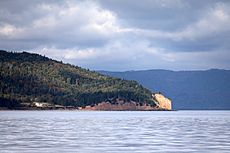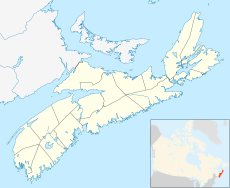Cape Dauphin facts for kids
Quick facts for kids Cape Dauphin |
|
|---|---|
| Kukumijinawenaq | |

Cape Dauphin from the mouth of the Great Bras d'Or
|
|
| Location | Victoria County, Nova Scotia |
| Coordinates | 46°20′31″N 60°24′57″W / 46.34194°N 60.41583°W |
| Offshore water bodies | Great Bras d'Or, St. Ann's Bay, Cabot Strait, Gulf of Saint Lawrence |
| Elevation | 20 m (66 ft) |
| Topo map | NTS O11/K08 |
Cape Dauphin is a special piece of land in Nova Scotia, Canada. It's a "headland," which means it's a high point of land that sticks out into the water. This cape is found in Victoria County, on the east side of Cape Breton Island.
Cape Dauphin acts like a natural divider. To its north is St. Ann's Bay, and to its south is the Great Bras d'Or channel, which is part of the large Bras d'Or Lake. Right behind the cape, to the southwest, is Cape Dauphin Mountain. This mountain rises high above the cape's shores, reaching about 334 meters (1,096 feet) tall.
The very tip of Cape Dauphin has a unique type of landscape called "karst topography." This means the rocks, usually limestone, have been shaped by water over time, creating interesting features like caves. One famous cave here is called "Fairy Hole." It's a sea cave, meaning it was formed by the ocean's waves. Local legends from the Mi'kmaq Nation are connected to this special cave.
Exploring Cape Dauphin
The Fairy Hole Trail is a path that runs along Cape Dauphin. It's named after Glooscap's Cave, another cave in the area that's part of Mi'kmaq stories. If you visit this beautiful area, it's always a good idea to be aware of your surroundings. Sometimes, wild animals like coyotes live in natural areas, so it's wise to take simple safety steps, like staying on marked trails and keeping an eye out.
The Mystery of Chinese Explorers
In 2006, a book called The Island of Seven Cities: Where the Chinese Settled When They Discovered America was published by Paul Chiasson. This book suggested that Chinese explorers might have visited Cape Dauphin in the 1400s. This would have been long before European explorers like the English or French arrived. The book claimed that these Chinese explorers might have left behind some ruins on the cape.
However, experts in Nova Scotia looked into this claim. Archeologists, who are scientists who study old human history, went to Cape Dauphin to investigate. They carefully searched the area for any signs of an ancient settlement. After their research, these archeologists all agreed that there was no evidence of any human settlement, Chinese or otherwise, in that specific area. This means the idea of Chinese explorers settling there is not supported by what they found.




